Unlocking the Potential of Family Farms: Inclusion in Rural Development Program Measures in Croatia
Abstract
1. Introduction
1.1. Environmental Significance of Family Farms in Rural Development Context of CAP EU
1.2. Family Farming in Croatia: History, Structure, and Trends
1.3. Alignment with the Croatian CAP, RDP, and Nature Objectives
2. Materials and Methods
2.1. Data Processing
2.2. Application of Regression and Nonparametric Tests in Data Evaluation
- p/(1 − p)—represents the odds, or the ratio of the probability that the outcome will occur;
- log(p/(1 − p))—is the logit function (the logarithm of the odds);
- β0—is the intercept (constant);
- βi: is the regression coefficient for each independent variable Xi.
2.3. Qgis for Spatial Data Analysis
3. Results
3.1. Analysis of the Use of Measure 10—Agriculture, Environment, and Climate Change
3.2. Analysis of the Use of Measure 11—Organic Farming
3.3. Analysis of the Use of Measure 13—Payments to Areas Facing Natural Constraints
4. Discussion
5. Conclusions
Author Contributions
Funding
Data Availability Statement
Conflicts of Interest
References
- Lowder, S.K.; Sánchez, M.V.; Bertini, R. Farms, Family Farms, Farmland Distribution and Farm Labour: What Do We Know Today? FAO Agricultural Development Economics Working Paper. Food Security and Nutrition. 2019. Available online: https://www.fao.org/agrifood-economics/publications/detail/en/c/1252236/ (accessed on 25 February 2025).
- Lowder, S.K.; Sánchez, M.V.; Bertini, R. Which farms feed the world and has farmland become more concentrated? World Dev. 2021, 142, 105455. [Google Scholar] [CrossRef]
- Eurostat. Agriculture Statistics—Family Farming in the EU. 2023. Available online: https://ec.europa.eu/ (accessed on 25 February 2025).
- Klikocka, H.; Zakrzewska, A.; Chojnacki, P. Characteristics of Models of Farms in the European Union. Sustainability 2021, 13, 4772. [Google Scholar] [CrossRef]
- Bélières, J.; Philippe, B.; Bosc, P.; Losch, B.; Marzin, J.; Sourisseau, J.-M. Family Farming Around the World. Definitions, Contributions and Public Policies. A Savoir: AFD. Report. 2015. Available online: https://www.researchgate.net (accessed on 27 May 2025).
- OECD. Innovation, Productivity and Sustainability in Food and Agriculture: Main Findings from Country Reviews and Policy Lessons; OECD Food and Agricultural Reviews; OECD Publishing: Paris, France, 2019. [Google Scholar] [CrossRef]
- Czekaj, M.; Adamsone-Fiskovica, A.; Tyran, E.; Kilis, E. Small farms’ resilience strategies to face economic, social, and environmental disturbances in selected regions in Poland and Latvia. Glob. Food Secur. 2020, 26, 100416. [Google Scholar] [CrossRef]
- Dorward, A.; Hazell, P.B.R.; Poulton, C.; Wiggins, S. The Future of Small Farms for Poverty Reduction and Growth; 2020 vision discussion papers 42; International Food Policy Research Institute (IFPRI): Washington, DC, USA, 2007. [Google Scholar]
- Graeub Benjamin, E.; Chappell, M.J.; Wittman, H.; Ledermann, S.; Kerr, R.B.; Gemmill-Herren, B. The State of Family Farms in the World. World Dev. 2016, 87, 1–15. [Google Scholar] [CrossRef]
- Raney, T.; Croppenstedt, A.; Anriquez, G.; Lowder, S. The State of Food and Agriculture 2010–11: Women in Agriculture: Closing the Gender Gap for Development; Food and Agriculture Organization: Rome, Italy, 2011; Available online: https://www.fao.org/4/i2050e/i2050e.pdf (accessed on 25 February 2025).
- Altieri, M. Agroecology, Small Farms, and Food Sovereignty. Mon. Rev. 2009, 61, 102. [Google Scholar] [CrossRef]
- Zimmerer, K.; Carney, J.; Vanek, S. Sustainable Smallholder Intensification in Global Change? Pivotal Spatial Interactions, Gendered Livelihoods, and Agrobiodiversity. Curr. Opin. Environ. Sustain. 2015, 14, 49–60. [Google Scholar] [CrossRef]
- Ricciardi, V.; Mehrabi, Z.; Wittman, H.; James, D.; Ramankutty, N. Higher yields and more biodiversity on smaller farms. Nat. Sustain. 2021, 4, 651–657. [Google Scholar] [CrossRef]
- Pe’er, G.; Lakner, S.; Passoni, G.; Azam, C.; Berger, J.; Hartmann, L.; Schüler, S.; Müller, R.; von Meyer-Höfer, M.; Zinngrebe, Y. Is the CAP Fit for Purpose? An Evidence-Based, Rapid Fitness-Check Assessment—Preliminary Summary of Key Outcomes. Leipzig, June 2017. Available online: https://www.researchgate.net/publication/318361763_Is_the_CAP_Fit_for_purpose_An_evidence-based_rapid_Fitness-Check_assessment_-_Preliminary_Summary_of_key_outcomes_Leipzig_2017 (accessed on 29 June 2025).
- Batáry, P.; Dicks, L.V.; Kleijn, D.; Sutherland, W.J. The role of agri-environment schemes in conservation and environmental management. Conserv. Biol. 2015, 29, 1006–1016. [Google Scholar] [CrossRef]
- OECD. Evaluation of Agri-Environmental Policies: Selected Methodological Issues and Case Studies; OECD Publishing: Paris, France, 2015. [Google Scholar] [CrossRef]
- European Court of Auditors. Is Agri-Environment Support Well Designed and Managed? Special Report No 7. 2011. Available online: https://www.eca.europa.eu (accessed on 27 May 2025).
- Capitanio, F.; Adinolfi, F.; Malorgio, G. What explains farmers’ participation in Rural Development Policy in Italian southern region? an empirical analysis. New Medit 2011, 10, 19–24. [Google Scholar]
- Grammatikopoulou, I.; Pouta, E.; Myyrä, S. Exploring the determinants for adopting water conservation measures. What is the tendency of landowners when the resource is already at risk? J. Environ. Plan. Manag. 2015, 59, 993–1014. [Google Scholar] [CrossRef]
- Cullen, P.; Hynes, S.; Ryan, M.; O’Donoghue, C. More than two decades of Agri-Environment schemes: Has the profile of participating farms changed? J. Environ. Manag. 2021, 292, 112826. [Google Scholar] [CrossRef]
- Novak, A.; Šumrada, T.; Černič Istenič, M.; Erjavec, E. Farmers’ decision to participate in agri-environmental measures for the conservation of extensive grasslands in the Haloze region. Acta Agric. Slov. 2022, 118, 1–16. [Google Scholar] [CrossRef]
- Defrancesco, E.; Gatto, P.; Runge, F.; Trestini, S. Factors Affecting Farmers’ Participation in Agri-environmental Measures: A Northern Italian Perspective. J. Agric. Econ. 2008, 59, 114–131. [Google Scholar] [CrossRef]
- Vanslembrouck, I.; Van Huylenbroeck, G.; Verbeke, W. Determinants of the Willingness of Belgian Farmers to Participate in Agri-environmental Measures. J. Agric. Econ. 2002, 53, 489–511. [Google Scholar] [CrossRef]
- Chaplin, H.; Davidova, S.; Gorton, M. Agricultural adjustment and the diversification of farm households and corporate farms in Central Europe. J. Rural Stud. 2004, 20, 61–77. [Google Scholar] [CrossRef]
- Ministry of Agriculture. Annual Report on the State of Agriculture in 2022. 2023. Available online: https://poljoprivreda.gov.hr (accessed on 3 March 2025).
- The Croatian Bureau of Statistics (DZS). Statistical Information 2023. Available online: https://podaci.dzs.hr/media/t4jbehpz/stat-info-2023.pdf (accessed on 28 May 2025).
- FAO Family Farming Knowledge Platform—Croatia. 2021. Available online: https://www.fao.org/family-farming/countries/hrv/en/ (accessed on 28 May 2025).
- Narodne Novine. Zakon o Obiteljskom Poljoprivrednom Gospodarstvu. 2018. Available online: https://narodne-novine.nn.hr/clanci/sluzbeni/2018_03_29_585.html (accessed on 25 February 2025).
- Narodne Novine. Pravilnik o Upisniku Obiteljskih Poljoprivrednih Gospodarstava. 2023. Available online: https://narodne-novine.nn.hr/clanci/sluzbeni/2023_07_80_1267.html (accessed on 25 February 2025).
- Župančić, M. Obiteljska poljoprivredna gospodarstva i ruralni razvitak u Hrvatskoj. Sociol. Prost. 2005, 43, 171–194. [Google Scholar]
- Defilippis, J. Razvoj obiteljskih gospodarstava Hrvatske i zadrugarstvo. Sociol. Prost. 2005, 43, 43–59. [Google Scholar]
- Žimbrek, T.; Franić, R.; Juračak, J. Strateški prioriteti hrvatske poljoprivrede—ograničenja i mogućnosti. Agroecon. Croat. 2001, 1, 1–14. [Google Scholar]
- Franić, R.; Žimbrek, T.I.; Grgić, Z. Agrarna politika u Republici Hrvatskoj na putu od poljoprivrednoga do održivoga ruralnog razvitka. Društvena Istraživanja 2003, 12, 1027–1049. [Google Scholar]
- Mikuš, O.; Franić, R.; Radić, T.; Kovačićek, T. Harmonization with the Common agricultural policy for a new member state: The case of Croatia. Econ. Eng. Agric. Rural Dev. 2020, 20, 375–381. [Google Scholar]
- Official Journal of the EU. Regulation (EU) No 1307/2013 of the European Parliament and of the Council of 17 December 2013 Establishing Rules for Direct Payments to Farmers Under Support Schemes Within the Framework of the Common Agricultural Policy and Repealing Council Regulation (EC) No 637/2008 and Council Regulation (EC) No 73/2009. Available online: https://eur-lex.europa.eu (accessed on 29 May 2025).
- Narodne Novine. Pravilnik o Višestruskoj Sukladnosti [Regulation on Cross-Compliance]. NN 113/2019. 2019. Available online: https://narodne-novine.nn.hr/clanci/sluzbeni/2019_11_113_2277.html (accessed on 29 May 2025).
- Narodne Novine. Pravilnik o Provedbi Izravne Potpore Poljoprivredi i IAKS Mjera Ruralnog Razvoja za 2022. Godinu [Regulation on the Implementation of Direct Payments in Agriculture and IAKS Rural Development Measures in 2022]. NN 27/2022. 2022. Available online: https://narodne-novine.nn.hr/clanci/sluzbeni/2022_03_27_352.html (accessed on 29 May 2025).
- Rac, I.; Erjavec, K.; Erjavec, E. Agriculture and environment: Friends or foes? Conceptualising agri-environmental discourses under the European Union’s Common Agricultural Policy. Agric. Hum. Values 2024, 41, 147–166. [Google Scholar] [CrossRef]
- Ministry of Agriculture. Rural Development Programme of the Republic of Croatia for the Period 2014–2020. 2015. Available online: https://ruralnirazvoj.hr (accessed on 3 March 2025).
- European Commission. Factsheet on 2014–2020 Rural Development Programme for Croatia. 2025. Available online: https://agriculture.ec.europa.eu (accessed on 29 May 2025).
- The Paying Agency for Agriculture, Fisheries and Rural Development (APPRRR). Farmers’ Register. Available online: https://www.apprrr.hr/upisnik-poljoprivrednika/ (accessed on 29 May 2025).
- Wickham, H.; François, R.; Henry, L.; Müller, K.; Vaughan, D. dplyr: A Grammar of Data Manipulation. R Package Version 1.1.4. 2023. Available online: https://dplyr.tidyverse.org (accessed on 15 March 2025).
- Pebesma, E.; Bivand, R. Spatial Data Science: With Applications in R, 1st ed.; Chapman and Hall/CRC: Boca Raton, FL, USA, 2023; 314p. [Google Scholar] [CrossRef]
- Al Bairmani, Z.A.A.; Ismael, A.A. Using Logistic Regression Model to Study the Most Important Factors Which Affects Diabetes for The Elderly in The City of Hilla/2019. J. Phys. Conf. Ser. 2021, 1818, 012016. [Google Scholar] [CrossRef]
- QGIS Development Team. QGIS Geographic Information System. Open Source Geospatial Foundation Project 2024. Available online: http://qgis.org (accessed on 7 April 2025).
- Blaće, A.; Čuka, A.; Šiljković, Ž. How dynamic is organic? Spatial analysis of adopting new trends in Croatian agriculture. Land Use Policy 2020, 99, 105036. [Google Scholar] [CrossRef]
- Wilson, G.; Hart, K. Financial Imperative or Conservation Concern? EU Farmers’ Motivations for Participation in Voluntary Agri-Environmental Schemes. Environ. Plan. A 2020, 32, 2161–2185. [Google Scholar] [CrossRef]
- Burton, R.J.F.; Kuczera, C.; Schwarz, G. Exploring Farmers’ Cultural Resistance to Voluntary Agri-environmental Schemes. Sociol. Rural. 2008, 48, 16–37. [Google Scholar] [CrossRef]
- Sachs, C.E.; Barbercheck, M.E.; Brasier, K.J.; Kiernan, N.E.; Terman, A.R. The Rise of Women Farmers and Sustainable Agriculture; University of Iowa Press: Iowa City, IA, USA, 2016; 196p. [Google Scholar]
- Genius, M.; Pantzios, C.J.; Tzouvelekas, V. Information acquisition and adoption of organic farming practices. J. Agric. Resour. Econ. 2006, 31, 93–113. [Google Scholar] [CrossRef]
- Azam, M.; Banumathi, M. The Role of Demographic Factors in Adopting Organic Farming: A Logistic Model Approach. Int. J. Adv. Res. 2015, 3, 713–720. [Google Scholar]
- Howden, S.M.; Soussana, J.F.; Tubiello, F.N.; Chhetri, N.; Dunlop, M.; Meinke, H. Adapting agriculture to climate change. Proc. Natl. Acad. Sci. USA 2007, 104, 19691–19696. [Google Scholar] [CrossRef]
- European Commission. Farm to Fork Strategy: For a Fair, Healthy and Environmentally-Friendly Food System. 2020. Available online: https://food.ec.europa.eu (accessed on 15 March 2025).
- Zimmermann, A.; Britz, W. European farms’ participation in agri-environmental measures. Land Use Policy 2016, 50, 214–228. [Google Scholar] [CrossRef]
- Espinosa, M.; Barreiro-hurle, J.; Ruto, E. What Do Farmers Want From Agri-Environmental Scheme Design? A Choice Experiment Approach. J. Agric. Econ. 2010, 61, 259–273. [Google Scholar] [CrossRef]

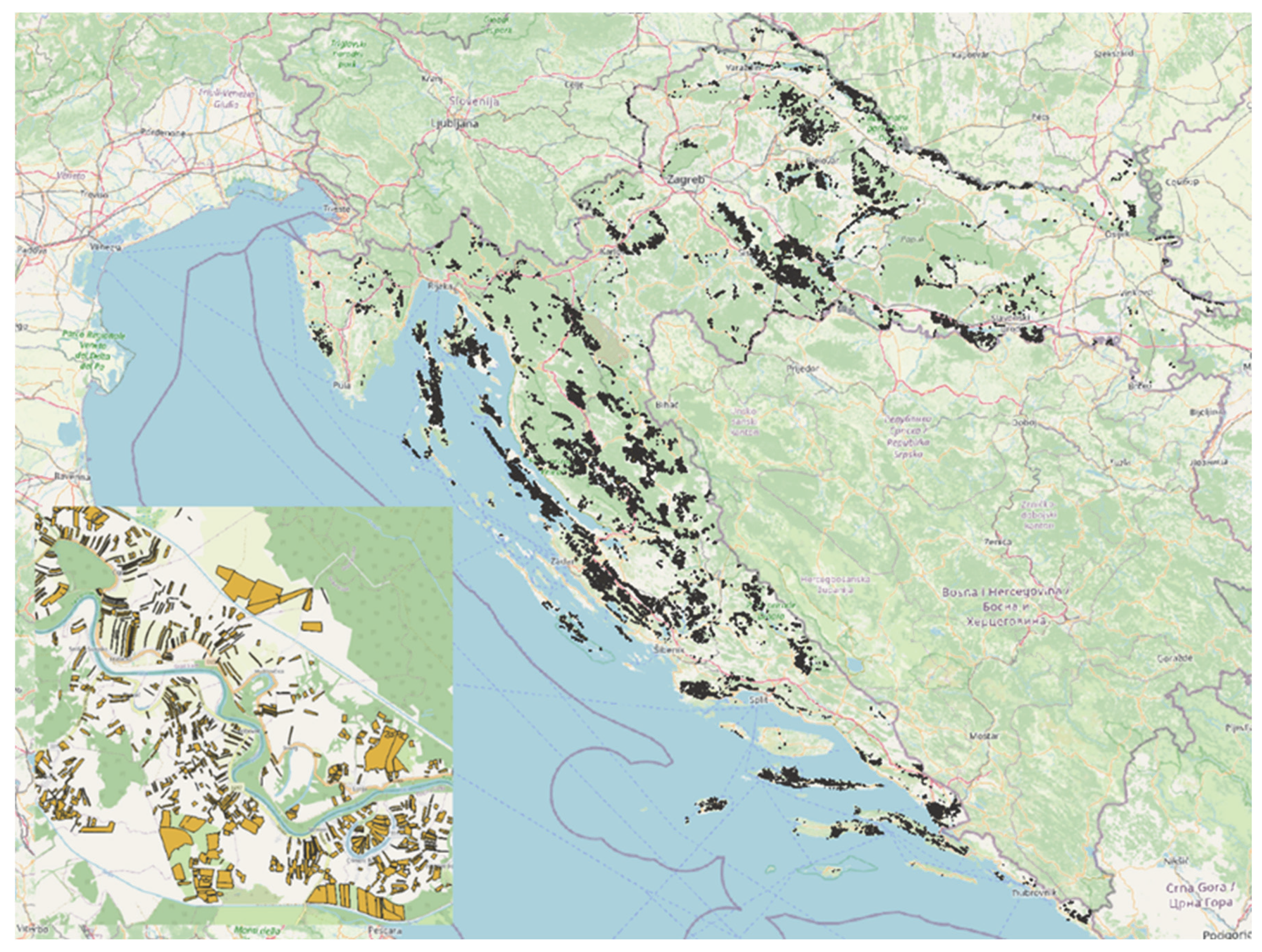

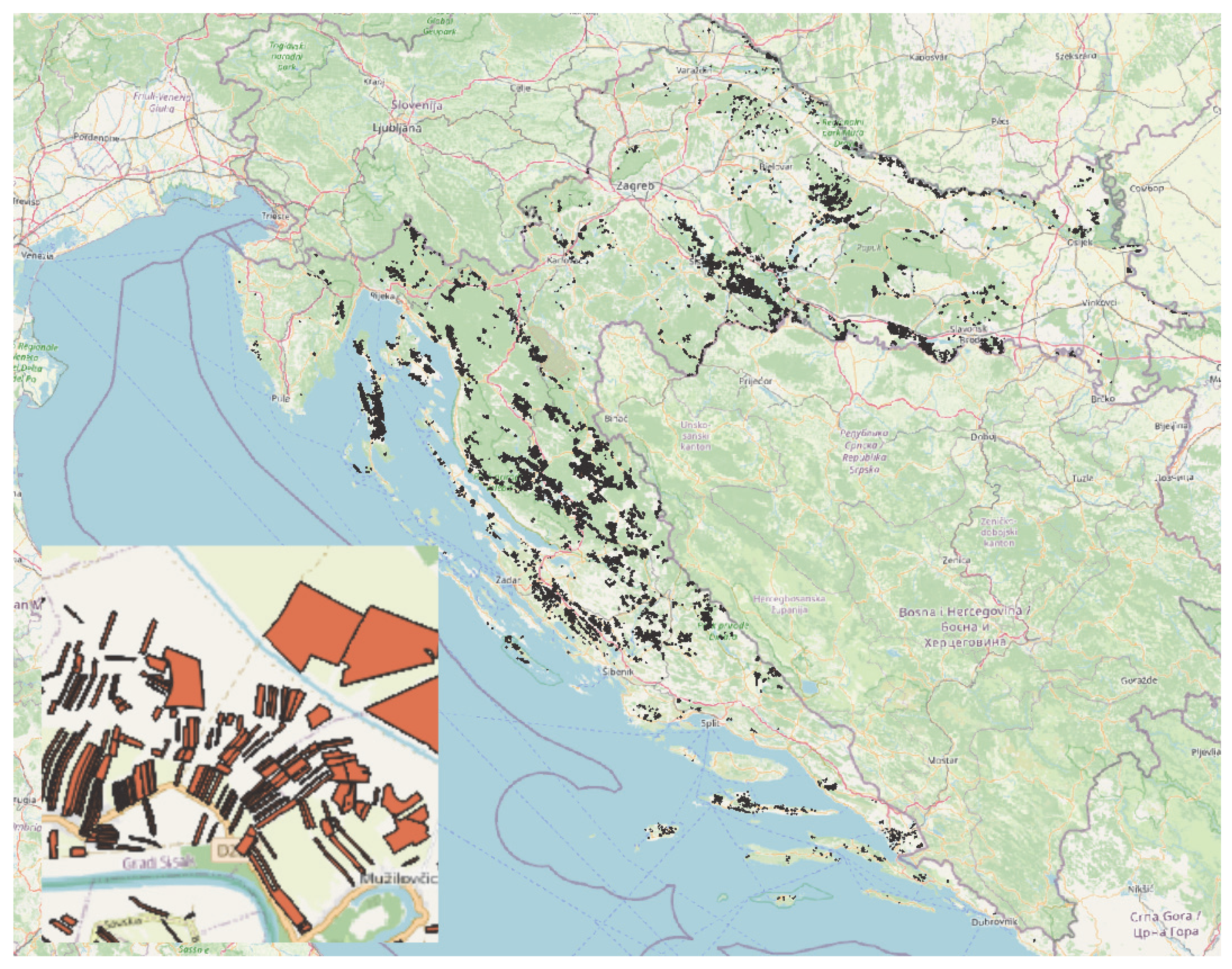
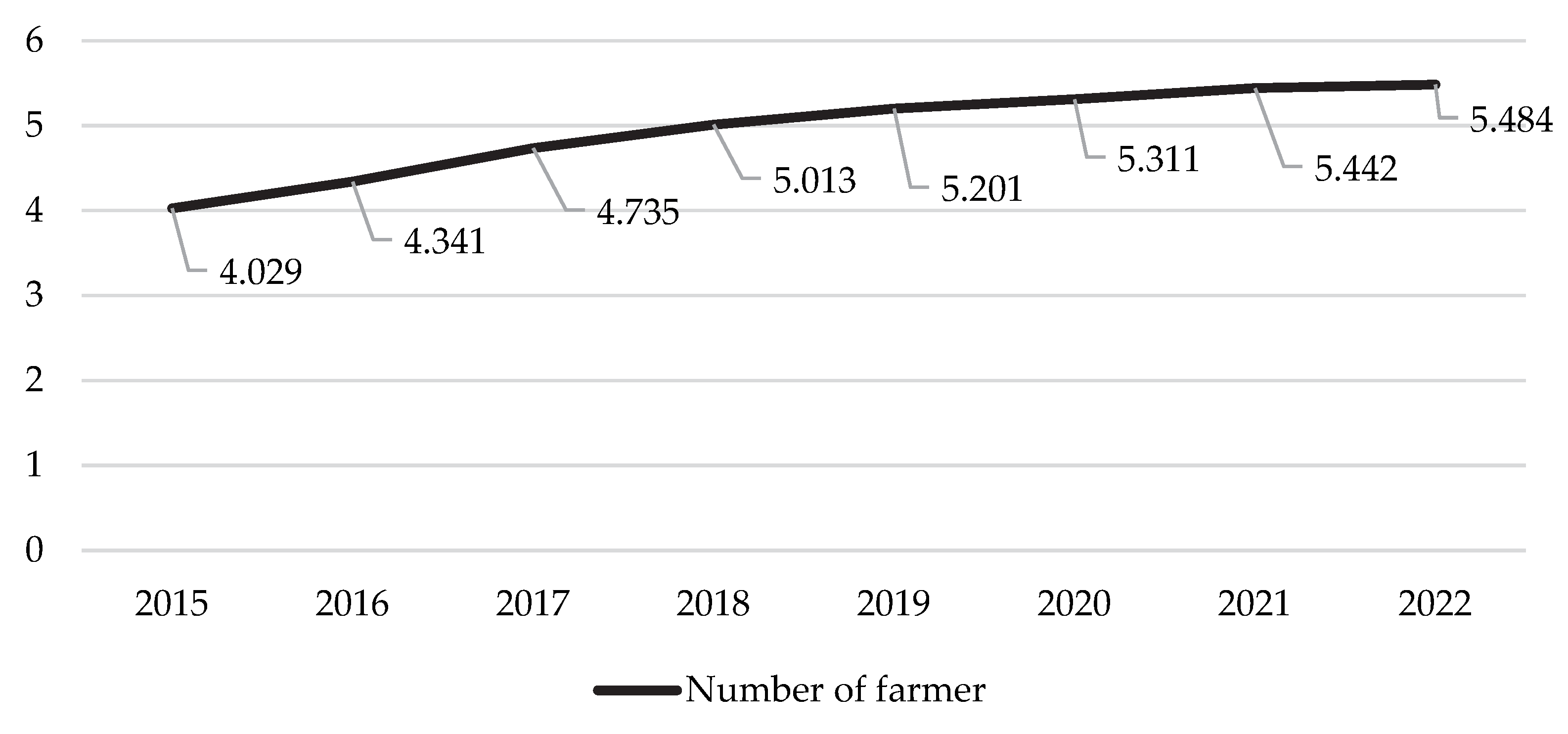
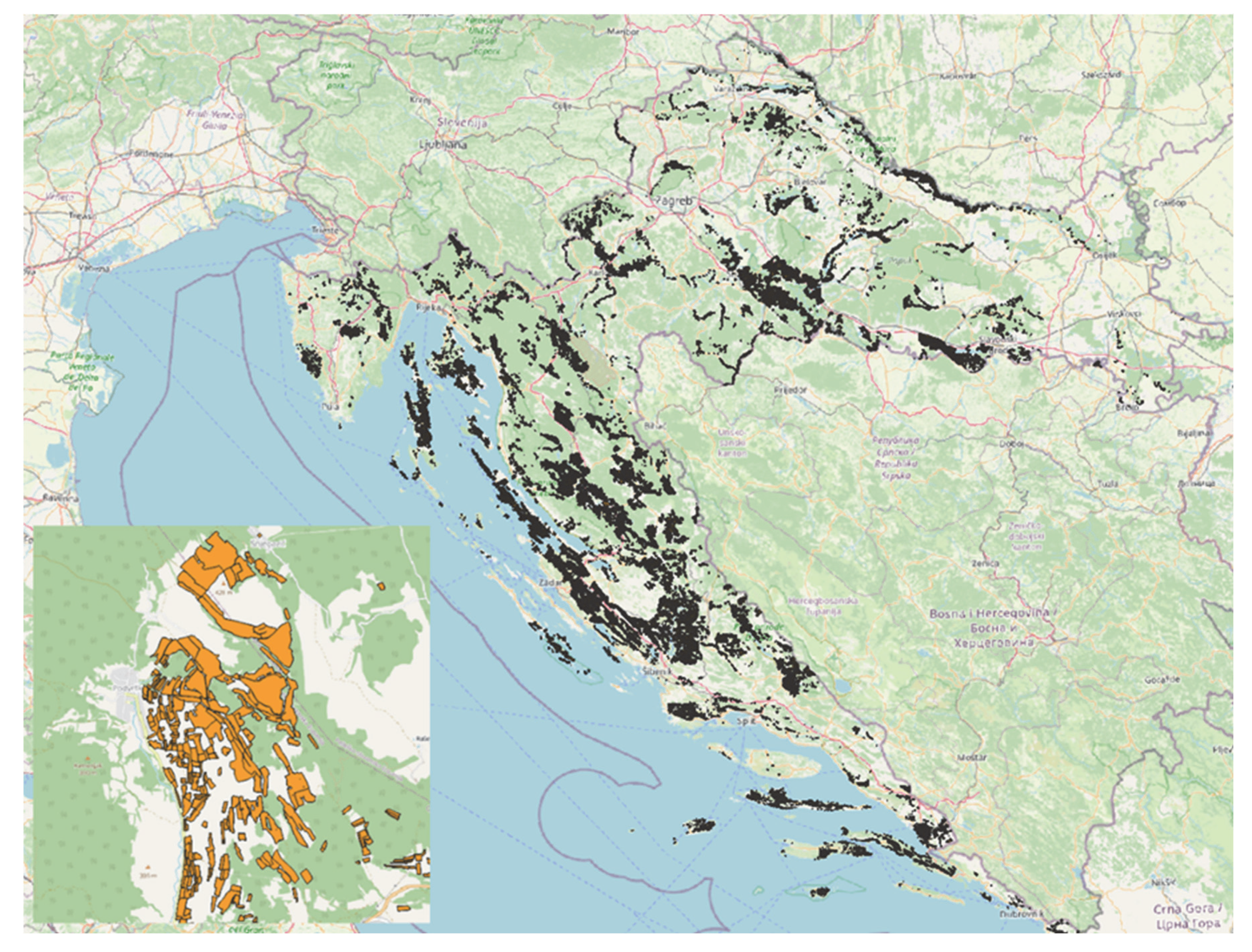
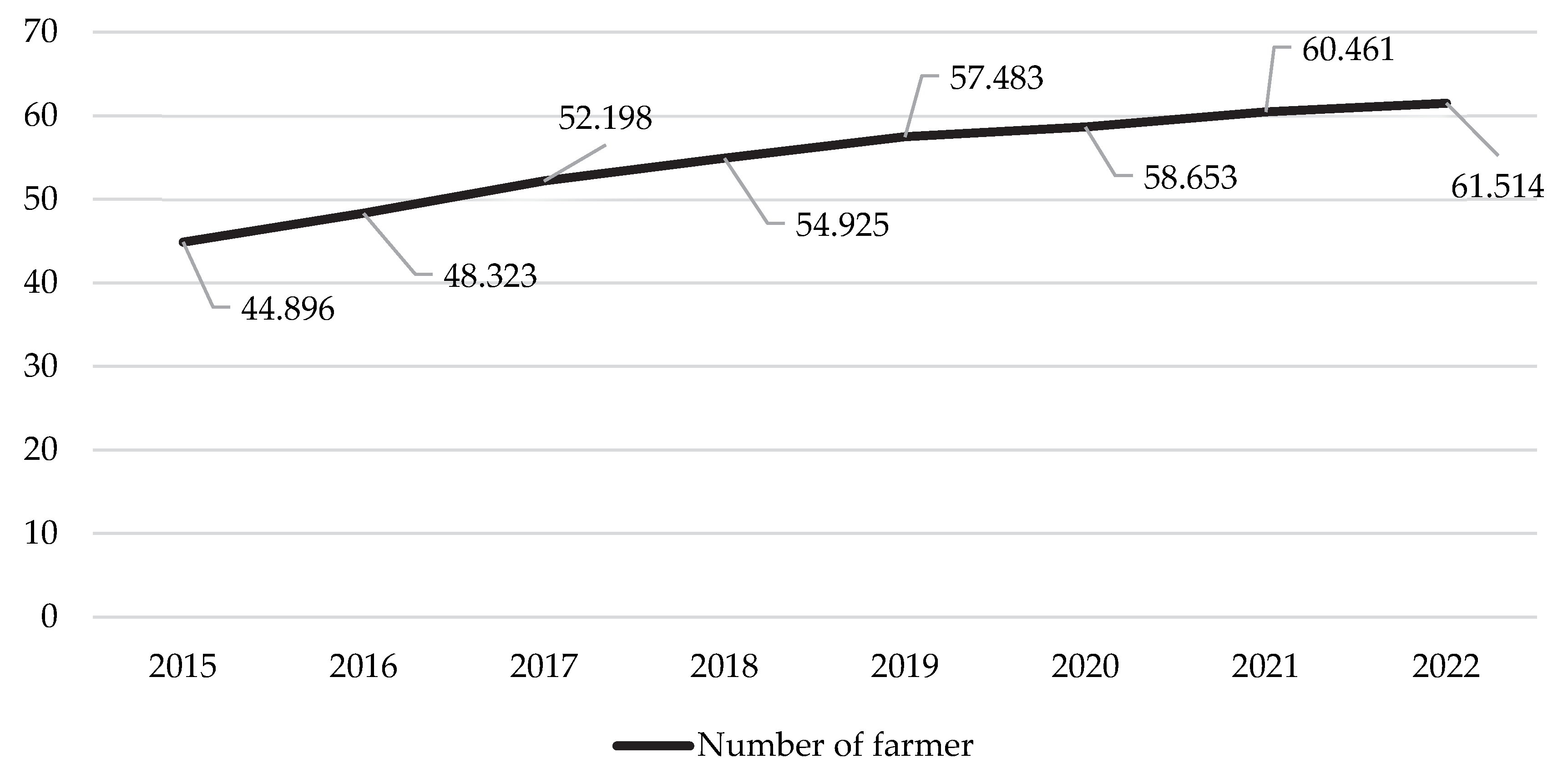
| Variable Name | Description | Measurement Unit/Category |
|---|---|---|
| Farm ID | Unique farm identification number | Number (e.g., 32,456) |
| Gender | Male or female | M or F |
| Date of Birth | Date of birth of the farm holder | Year (e.g., 1995) |
| Livestock Ownership | Indicates if the farm owns livestock | 1 = yes, 0 = no |
| Land Size | Total agricultural land used | Hectares (ha) |
| RDP Measure | Participation in measures M10, M11, M13 | 0 = no, 1 = yes, per measure |
| Age Category | Grouped age of farm holder | 1 = ≤40, 2 = 41–65, 3 = >65 |
| Education Level | Education of farm holder | 1 = no school, 2 = primary, 3 = secondary, 4 = university, 5 = unknown |
| N | % | |
|---|---|---|
| Gender | ||
| Male | 60,007 | 73.26 |
| Female | 21,900 | 26.73 |
| Unknown | 5 | 0.01 |
| Age in category | ||
| 1 | 12,760 | 15.58 |
| 2 | 39,400 | 48.10 |
| 3 | 29,752 | 36.32 |
| Education in category | ||
| 1 | 2819 | 3.44 |
| 2 | 15,238 | 18.60 |
| 3 | 31,918 | 38.97 |
| 4 | 6055 | 7.39 |
| Unknown | 25,882 | 31.60 |
| N | % | |
|---|---|---|
| Gender | ||
| Male | 13,925 | 75.81 |
| Female | 4474 | 24.18 |
| Unknown | 1 | 0.01 |
| Age in category | ||
| 1 | 3304 | 17.96 |
| 2 | 8992 | 48.87 |
| 3 | 6104 | 33.16 |
| Education in category | ||
| 1 | 363 | 1.97 |
| 2 | 2081 | 11.31 |
| 3 | 7933 | 43.11 |
| 4 | 2362 | 12.84 |
| Unknown | 5661 | 30.77 |
| χ2 | df | p | |
|---|---|---|---|
| Gender and M10 | 11,164 | 1 | <0.001 *** |
| Education and M10 | 344,387 | 3 | <0.001 *** |
| Livestock and M10 | 129,275 | 1 | <0.001 *** |
| Variable | B | S.E. | Wald | df | p | Exp(B) |
|---|---|---|---|---|---|---|
| Intercept | 0.6216 | 0.010 | 3863.87 | 1 | <0.001 *** | 1.862 |
| Gender (Male (vs. Female)) | 0.0449 | 0.005 | 80.71 | 1 | <0.001 *** | 1.046 |
| Education | ||||||
| Cat 2. (vs. Cat 1) | 0.1776 | 0.006 | 876.16 | 1 | <0.001 *** | 1.194 |
| Cat 3 (vs. Cat 1) | 0.8463 | 0.007 | 14,616.81 | 1 | <0.001 *** | 2.331 |
| Cat 4 (vs. Cat 1) | 1.4720 | 0.008 | 33,856.00 | 1 | <0.001 *** | 4.358 |
| Age | −0.0048 | 0.0002 | 574.08 | 1 | <0.001 *** | 0.995 |
| Animals | 0.6932 | 0.006 | 13,347.95 | 1 | <0.001 *** | 2.000 |
| N | % | |
|---|---|---|
| Gender | ||
| Male | 3975 | 72.48 |
| Female | 1509 | 27.52 |
| Age in category | ||
| 1 | 1383 | 25.22 |
| 2 | 3011 | 54.91 |
| 3 | 1090 | 19.87 |
| Education in category | ||
| 1 | 35 | 0.64 |
| 2 | 359 | 6.55 |
| 3 | 2435 | 44.39 |
| 4 | 981 | 17.89 |
| Unknown | 1674 | 30.53 |
| χ2 | df | p | |
|---|---|---|---|
| Gender and M11 | 718.36 | 1 | <0.001 *** |
| Education and M11 | 357,620 | 3 | <0.001 *** |
| Livestock and M11 | 564,542 | 1 | <0.001 *** |
| Variable | B | S.E. | Wald | df | p | Exp(B) |
|---|---|---|---|---|---|---|
| Intercept | −0.5269 | 0.0164 | 1027.88 | 1 | <0.001 *** | - |
| Gender (Male (vs. Female)) | −0.2685 | 0.0038 | 5011.52 | 1 | <0.001 *** | 0.764 |
| Education | ||||||
| Cat 2. (vs. Cat 1) | 1.0136 | 0.0146 | 4827.43 | 1 | <0.001 *** | 2.756 |
| Cat 3 (vs. Cat 1) | 1.8745 | 0.0144 | 16,976.94 | 1 | <0.001 *** | 6.511 |
| Cat 4 (vs. Cat 1) | 2.7675 | 0.0149 | 34,611.67 | 1 | <0.001 *** | 15.922 |
| Age | −0.0223 | 0.0001 | 42,230.66 | 1 | <0.001 *** | 0.978 |
| Animals | 1.4067 | 0.0052 | 71,801.04 | 1 | <0.001 *** | 4.085 |
| N | % | |
|---|---|---|
| Gender | ||
| Male | 45,052 | 73.23 |
| Female | 16,450 | 26.73 |
| Unknown | 12 | 0.02 |
| Age in category | ||
| 1 | 8088 | 13.15 |
| 2 | 26,984 | 43.86 |
| 3 | 26,442 | 42.99 |
| Education in category | ||
| 1 | 2559 | 4.16 |
| 2 | 10,492 | 17.05 |
| 3 | 23,870 | 38.81 |
| 4 | 4730 | 7.69 |
| Unknown | 19,863 | 32.29 |
| χ2 | df | p | |
|---|---|---|---|
| Gender and M13 | 1109.3 | 1 | <0.001 *** |
| Education and M13 | 114,461 | 3 | <0.001 *** |
| Livestock and M13 | 97,397 | 1 | <0.001 *** |
| Variable | B | S.E. | Wald | df | p | Exp(B) |
| Intercept | 0.087 | 0.01288 | 45.64 | 1 | <0.001 *** | - |
| Gender (Male (vs. Female)) | −0.037 | 0.00406 | 84.89 | 1 | <0.001 *** | 0.964 |
| Education | ||||||
| Cat 2. (vs. Cat 1) | −0.003 | 0.00945 | 0.10 | 1 | <0.001 *** | 0.997 |
| Cat 3 (vs. Cat 1) | 0.655 | 0.00953 | 4719.01 | 1 | 0.752 | 1.926 |
| Cat 4 (vs. Cat 1) | 0.723 | 0.01034 | 4890.14 | 1 | <0.001 *** | 2.061 |
| Age | 0.0088 | 0.00012 | 5505.77 | 1 | <0.001 *** | 1.009 |
| Animals | 1.220 | 0.00685 | 31,661.47 | 1 | <0.001 *** | 3.386 |
Disclaimer/Publisher’s Note: The statements, opinions and data contained in all publications are solely those of the individual author(s) and contributor(s) and not of MDPI and/or the editor(s). MDPI and/or the editor(s) disclaim responsibility for any injury to people or property resulting from any ideas, methods, instructions or products referred to in the content. |
© 2025 by the authors. Licensee MDPI, Basel, Switzerland. This article is an open access article distributed under the terms and conditions of the Creative Commons Attribution (CC BY) license (https://creativecommons.org/licenses/by/4.0/).
Share and Cite
Pečurlić, L.; Sudarić, T.; Kranjac, D.; Petrač, M.; Jelić Milković, S. Unlocking the Potential of Family Farms: Inclusion in Rural Development Program Measures in Croatia. Agriculture 2025, 15, 1432. https://doi.org/10.3390/agriculture15131432
Pečurlić L, Sudarić T, Kranjac D, Petrač M, Jelić Milković S. Unlocking the Potential of Family Farms: Inclusion in Rural Development Program Measures in Croatia. Agriculture. 2025; 15(13):1432. https://doi.org/10.3390/agriculture15131432
Chicago/Turabian StylePečurlić, Lucija, Tihana Sudarić, David Kranjac, Maja Petrač, and Sanja Jelić Milković. 2025. "Unlocking the Potential of Family Farms: Inclusion in Rural Development Program Measures in Croatia" Agriculture 15, no. 13: 1432. https://doi.org/10.3390/agriculture15131432
APA StylePečurlić, L., Sudarić, T., Kranjac, D., Petrač, M., & Jelić Milković, S. (2025). Unlocking the Potential of Family Farms: Inclusion in Rural Development Program Measures in Croatia. Agriculture, 15(13), 1432. https://doi.org/10.3390/agriculture15131432






